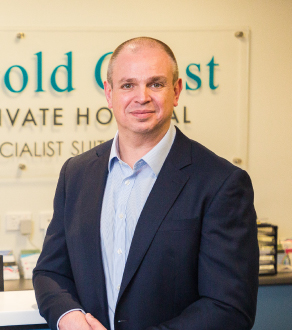
The most important instructions are to rest and elevate your foot after your surgery. This will reduce bleeding and swelling and ultimately reduce pain
Dr Platt works closely with a range of therapists to optimise and accelerate your recovery
Remember to ring and confirm your postoperative clinic visit (07) 5522 2026
In the first 24-48 hours after surgery you are likely to experience swelling and pressure in the
foot. This is normal; the more you keep the foot elevated, the quicker this will settle.
Do some gentle exercise. Dr Platt will tell you what exercise is right for you. Depending on your surgery, this will probably involve gentle movements to your ankle (up and down and rotation), and regular flexing and extending (wriggling) of toes.
You will find out what exercises are right for you before you leave the hospital, and again at your first therapy visit.
Recovery and return to function
Recovering from foot and ankle surgery can take up to 18 months, depending on the type of surgery that you have had. Your foot may be swollen for a few months. Most swelling settles down within 6 months.
Most people return to comfortable, day to day activities within 3 months and usual activity and
function generally returns within 6 months to a year.
If getting back into sport is your goal, your physical therapist will start your return to sport regime about 3 months after your surgery. Again, this will vary from individual to individual, and depend on the type of surgery that you have had.
These guidelines for recovery are broad and will vary between individuals. Dr Platt works closely with a range of therapists to optimise and accelerate your recovery. Therefore, your treatment and recovery journey will be customised to you.
Dr Platt will liaise directly with your therapy team with specific post operative instructions. Your initial therapy visit will address wound care, oedema management, cast/ brace fitting or modifications, and the prescription of your individualised rehabilitation exercises.
Please contact Dr Platt’s rooms if you experience any of the following:
Contact number (07) 5522 2026
Email [email protected]

Led by orthopaedic surgeon, Dr Simon Platt, Coast Foot and Ankle Surgery provides high quality, empathetic care to all patients.
View More- Acute fractures
- Arthroscopic (keyhole) surgery
- Bunions
- Complex foot and ankle procedures
- Sports Injuries
To make an appointment with Dr Platt, please call (07) 5522 2026. Remember, you will need to get a referral from your General Practitioner or medical specialist before your appointment.
Book HereTo make an appointment with Dr Platt, please call 07 5522 2026. Remember, you will need to get a referral from your General Practitioner or medical specialist before your appointment.

Copyright 2020 Coast Foot and Ankle | All Rights Reserved | Daniel Sim Design